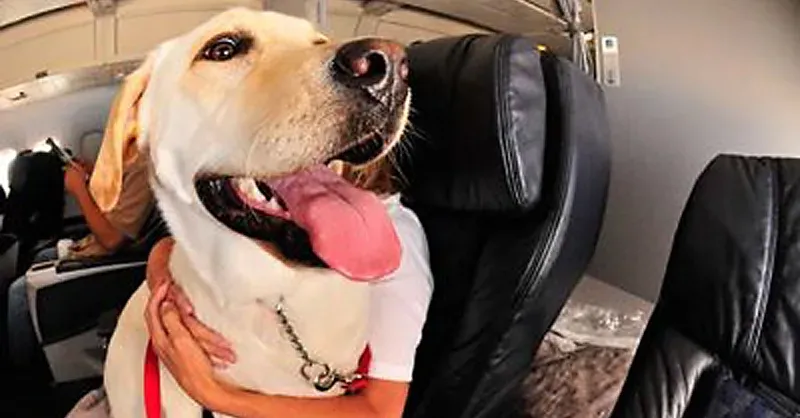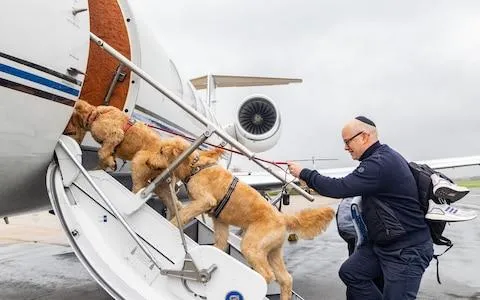Your Guide to Pet-Friendly Cabin Travel
Whether you’re looking to take your furry friend on vacation or simply don’t want to be separated during a work trip, finding flights that allow dogs in the cabin can make travel much more convenient and comfortable for both you and your pet. In this article, we’ll explore the options for bringing dogs along at 35,000 feet and answer all your questions about in-cabin pet policies.
Which Airlines Allow Dogs in the Cabin?
- Alaska Airlines: Allows one pet per passenger in the cabin in a carrier under the seat. Breed restrictions apply. Fee is $125 each way.
- American Airlines: Only small dogs in soft-sided carriers are allowed. Fee is $125 each way.
- Delta: Only small and medium dogs in carriers under the seat. Fee is $125 each way.
- JetBlue: Only dogs 8 lbs or less in carriers under the seat. Fee is $100 each way.
- Southwest: Only small dogs and cats combined weight of 20 lbs or less per passenger. Fee is $95 each way.
From my experience, Southwest has been the most pet-friendly airline. Their policy allows for bigger dogs than most as long as the passenger’s pets together don’t exceed 20 lbs.
What Size Carrier Is Accepted?
Most airlines require pets to travel in soft-sided carriers that fit completely under the seat in front of you. Carriers cannot exceed approximately 17″ x 13″ x 9″. It’s a good idea to measure your pet’s crate to be sure it meets size limits before booking your flight. Additionally, the carrier should be sturdy enough to withstand potential bumps and jostling during takeoff and landing. Look for carriers with plastic or metal reinforcements.
At the same time, avoid excessively large crates that could obstruct passengers’ feet or potentially exceed weight limitations for carry-on bags. Striking a balance between adequate space and portability will help ensure a smooth trip.
What Documents Are Needed?
All airlines require a health certificate from your veterinarian stating that your pet is fit to fly. The certificate typically needs to be valid within a certain number of days of your flight – usually 10 days or less.

Proof of current vaccinations against rabies, distemper, hepatitis, leptospirosis, and parainfluenza are also common airline requirements. Some airlines like Alaska require a signed letter from your vet describing your pet’s training and behavior as well.
Additionally, you’ll pay either a one-way or roundtrip fee when booking your pet’s ticket. Be sure to research individual airline policies to understand any restrictions and what paperwork you need to bring your furry friend along. Having documents in order will help avoid headaches at check-in.
How Can I Prepare My Pet for Takeoff and Landing?
Whether your pet normally gets plane or motion sickness, it’s a good idea to introduce calming aids before flying. Ask your vet about medications, calming treats or supplements containing ingredients like melatonin and try them in the weeks leading up to travel so your pet adjusts.
On travel day, limit food but still provide fresh water until it’s time to leave for the airport. Having an empty stomach can help with nausea, yet hydration remains important. Purchase extra absorbent pads or towels and bring them in a plastic bag for cleanups along with disinfectant wipes.
Soothing pheromone sprays and plugins for the carrier help alert pets stay calm during loud noises. Playing calming music, white noise apps or guided dog meditation videos on a phone or tablet inside the carrier provide pleasant distractions. So in summary, de-stress your pup with meds, sounds and activities tailored to their needs for a cozy cruise at 35,000 feet!

What If My Pet Acts Out on the Plane?
Basically, you’ll be asked to leave the plane if your pooch pitches a fit. No doggy toddler temper tantrums are allowed! Most airlines have a three strikes policy – if Fido barks excessively, claws at the carrier or shows signs of severe stress after warnings, you’ll be removed for fellow passengers’ comfort.
Here’s a tip I learned from experience – train your pet extensively to “Quiet” or “Hush” commands before flying. Practice keeping them calmly distracted with toys and chews in louder environments. Ensure the carrier is a safe, dark and cozy den for your pal to handle takeoff and landing. Sometimes our furry friends kind of panic, but with prep work, most fly with flying colors. Stay positive and be prepared to step off the plane if needed for everyone’s safety. With diligent preparation, 99% of dogs do amazingly well!
Hope this guide provides answers about transporting your canine companion! Let me know if any other pet travel questions come to mind. With vaccinations, certified carriers and the right calming techniques, flying with Fido in the cabin can be a breeze, rather than a pain in the tail. Safe travels to you and your pup!
Airlines That Allow Dogs in Cabin
| Airline | Weight Limit | Cabin Size Limit | Cage/Crate Requirement |
|---|---|---|---|
| United | 33 lbs | 20 inches | Soft-sided carrier under seat |
| American | 25 lbs | 18 inches | Hard-sided carrier under seat |
| Delta | 20 lbs | Linear dimension of 18 inches or less | Under-seat hard-sided kennel required |
| Alaska | 20 lbs | Linear dimension of 18 inches or less | Hard-sided kennel required under seat |
| Southwest | 20 lbs including carrier | Carrier must fit under seat | Soft-sided carrier only |
FAQ
-
Which airlines allow dogs in the cabin?
Basically, most major airlines let you bring a dog in the cabin as long as it meets certain size and weight limits. Airlines like American, Delta, and United let you bring small dogs on board for a fee.
-
What are the size and weight limits for cabin pets?
Generally, dogs have to fit under the seat in a carrier and weigh 20 pounds or less. Some airlines have even smaller limits, maybe 15 pounds or less. You’ll need to check the specific rules for your airline ’cause they can vary a little bit.

-
Do I need to buy my dog its own ticket?
Yep, you’ll need to purchase a ticket for your furry friend. Ticket prices differ by airline but usually run between $100-250 each way. However, at the same time, it’s much better than putting your pooch in the cargo hold!
-
Are there any paperwork requirements?
You’ll need a bunch of paperwork for an in-cabin pet. Most importantly, you need an approved carrier and health records signed by your vet within a year. Don’t forget to check if there are any state-to-state pet travel laws too. It’s definitely a whole process but possible if you plan ahead.
-
What if my dog acts out on the plane?
If Fido starts barking or crying non-stop during the flight, you may get asked to take him out of the cabin. Airlines have the right to refuse any pet that’s disruptive. So maybe bring treats or toys to keep your pup entertained. With some training beforehand though, most dogs do just fine on flights.
-
Should I consider flying my dog as cargo instead?
Perhaps. For large or anxious dogs, cargo might be better than being cooped up under the seat for hours. But there are risks too – delays happen and you can’t check on your pal. Most experts suggest trying to fly cabin if possible. Ask your vet what’s safest for your pup’s personality.
-
Any last tips for flying with dogs?
In addition to all the paperwork and other requirements, it’s a good idea to get your dog accustomed to the carrier before the big day. Basic obedience training helps too. And maybe bring along your pup’s favorite toys or treats for reassurance. With proper planning, most dogs can handle flight like a champion!

